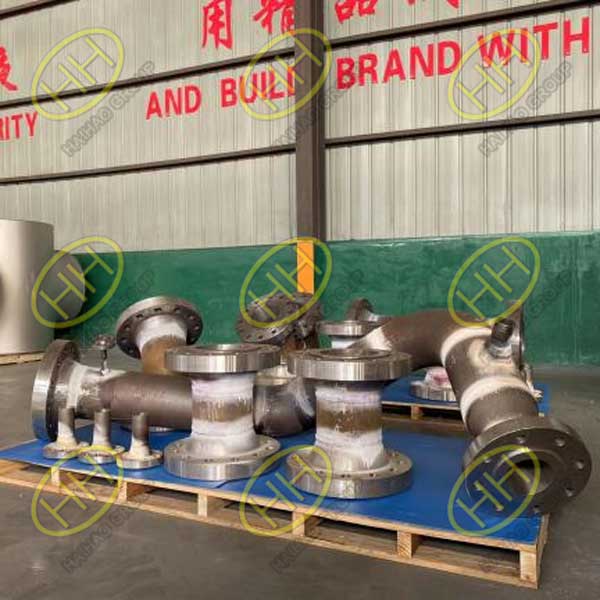-
Recently, a German client ordered a batch of ASME B16.9 A106 Gr. B 180° SR elbows from Haihao Group. This product is a critical component in pipeline systems, especially where a 180-degree turn is required in compact spaces. The ASME B16.9 A106 Gr. B 180° ...
-
At Haihao Group, we are pleased to announce the successful fulfillment of an order for a valued client in Qatar. This shipment features a comprehensive batch of ASME B16.9 pipe fittings, specifically designed to meet the rigorous demands of various industr ...
-
Salt spray testing is divided into two main categories: natural environment exposure testing and artificial accelerated salt spray environment testing. The latter involves using specialized equipment, known as a salt spray test chamber, where an artificial ...
-
Haihao Group proudly participated in Tube China 2024, where we successfully handled hundreds of clients from various industries. Our team’s professionalism, strict standards, and genuine approach earned the trust of many, making them choose Haihao Gr ...
-
Haihao Group has been actively involved in numerous marine pipeline projects, including subsea pipelines, large ship piping systems, and offshore drilling platforms. Many of these projects require that the piping system products undergo rigorous salt spray ...
-
Haihao Group is proud to announce the production of MSS-SP-97 ASTM A105 sockolets for our valued client in Singapore. Sockolets are specialized fittings that enable the branching off of a smaller pipe from a larger one, offering a seamless and efficient wa ...
-
First, let’s clarify the purpose of the pressure test. The pressure test is conducted to ultimately verify the overall strength and reliability of a pressure vessel. It assesses the manufacturing quality, the strength and rigidity of each pressure-be ...
-
The 2024 International Pipe Exhibition will be held at the Shanghai New International Expo Center from September 25 to 28, 2024.This premier event will showcase the latest advancements in tube and pipe manufacturing technologies, and we are thrilled to be ...
-
The mechanical properties of metallic materials play a crucial role in determining their performance and durability in various applications, especially in the field of mechanical engineering. These properties include strength, plasticity, hardness, impact ...
-
Choosing the right materials for pressure vessels is crucial for both economic efficiency and safety. The following guidelines outline how to select materials that strike a balance between cost-effectiveness and suitability for the intended use. 1.General ...
-
In the design and operation of pressure vessels, several key temperature parameters are critical for ensuring safety and functionality. These include operating temperature, metal temperature, design temperature, and the minimum design metal temperature (MD ...
-
Cyclic failure modes refer to the types of failures that occur in pressure vessels after long periods of operation under cyclic loading conditions. These failures develop as the vessel is repeatedly subjected to loading and unloading cycles, which can lead ...
-
Pressure vessels are subject to various failure modes, classified into short-term, long-term, and cyclic failures. This article focuses on long-term failure modes, which occur over an extended period under non-cyclic loading. These modes include creep rupt ...
-
Pressure vessels can experience various failure modes, typically categorized into three types: (1) short-term failure modes, (2) long-term failure modes, and (3) cyclic failure modes. This article focuses on short-term failure modes, which occur suddenly u ...
-
Recently, Haihao Group had the opportunity to assist an Indonesian customer with a specialized request. The customer sought two distinct products: stainless steel woven mesh and square hollow section steel pipes. As a company with over forty years of exper ...
-
The type testing project for rotary compensators are comprehensive process that ensures the product meets all necessary standards and specifications. 1.Technical Document Review The type testing of rotary compensators involves a thorough review of technica ...
-
Rotary compensators, also known as rotary expansion joints, are mechanical devices used in piping systems to absorb and compensate for thermal expansion, contraction, and other movements. These compensators are designed to accommodate rotational and angula ...
-
Quenching and tempering is a heat treatment process used to improve the mechanical properties of metals and alloys. The process involves heating the material to a high temperature, then cooling it rapidly (quenching), followed by reheating it to a lower te ...
-
Quenched and tempered steel undergoes a heat treatment process that includes both preliminary and final heat treatments. The objective is to achieve steel with a balanced combination of strength, toughness, and hardness, making it ideal for mechanical part ...
-
Quenched and tempered steels are categorized based on their hardenability into three types: low, medium, and high hardenability steels. These steels are widely used in various mechanical applications due to their ability to undergo heat treatment, which en ...



















